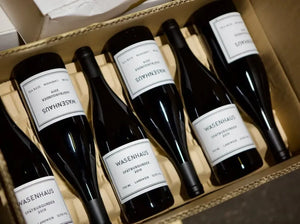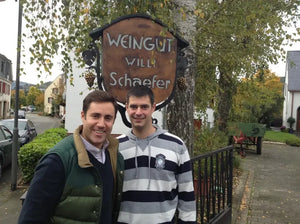Blog » Germany
-
Anything but Ordinaire: Wasenhaus Spatburgunder
The hunt for German Pinot Noir producers who get it is a never-ending pursuit. Much of the point-chasing efforts from estates in Baden (Pinot Noir territory) are overly masked through excessive oak, extraction, and out-of-whack ripeness seemingly intended to elicit oohs and ahs from tasters as if they had finally made that Burgundy-beater. Any German producer intent on outshowing Burgundy would be better suited in another line of work.
Today's afternoon offer is exciting for a couple of different reasons. First, Alexander Götze and Christoph Wolber have spent over a decade working at Burgundian domaines like Leflaive, De Montille, Pierre Morey, and Comte Armand. Secondly, I have fond memories of spending time with Alex during my year-long stint in Beaune. His goal was always to return to Germany and produce Pinot Noir that followed the sensibilities that the Côte d'Or naturally transmitted.
Wasenhaus is Pinot Noir at its most ethereal. For me, the entry-level bottling, Grand Ordinaire, is the highlight of the lineup. The delicacy and levity here brought an up-front drinkability and ease that's undeniably delicious and equally brilliant. No doubt, the duo's experience in Burgundy imparted an important lesson: That great wine is made in the vineyard and raised with a soft touch in the cellar.
Much of the elegance in the Wasenhaus range can be attributed to working with vineyards with a higher content of limestone and sand versus the heavier clay soils that are more common throughout Baden. As you can imagine, those with an eye toward grace above power will choose their sites wisely.
The Spätburgunder ferments with 90% destemmed fruit and 10% whole clusters. Aging takes place in neutral barrel for one year, followed by six months in stainless steel. This switch really benefits the wine as it holds in those more crunchy and bright red berry fruit characteristics. The lingering finish with sweet brown spices and savory tones is persistent, especially given the humble price point.
I'm always up for tasting German Pinot Noir, but I rarely find wines that pull me in like red Burgundy. For Wasenhaus, it's the effortless sensibility and focus on terroir that shines the brightest. -
Mosel Lace: Willi Schaefer Riesling
Putting aged Willi Schaefer wines on the website is one of the hardest things I do. These personal wines will only improve as the decades pass, while quantities will be long gone. Now, off-dry German Riesling clearly pairs well with spicy cuisine, my first pick for favorite Thai and Szechuan, but the magic of pairing with a pork shoulder and other heavier proteins always feels like it was destined.
Recently I was at Majordōmo L.A. and was so close to ordering a 1990 Mosel Riesling with the Bo Ssam pork shoulder. We went in another direction, but that just means that if this 2001 Dombprobst Spätlese below doesn't sell, then I'm going to just bring it back there next dinner.
The balanced Rieslings found in Mosel River Valley captivate at every turn, but for me, Willi Schaefer sits in a select category. These wines have long impressed me for their featherweight lightness and mineral spring purity. Along with J.J. Prüm, this is where the Mosel reaches its crescendo.
Schaefer's minute holding of 4.2 hectares focuses on two vineyards in the village of Graach—Himmelreich and Domprobst—both comprised of Devonian slate soils. Visiting Christoph Schaefer at his family's cellar, situated at the foot of the wickedly steep Domprobst Vineyard, was an unforgettable experience (See picture below).
In its youth, Himmelreich is the more approachable, fruity, and silky, with lots of citrus and white peach. Its nimble weightlessness personifies the magic of the Mosel. Domprobst, in comparison, is much deeper, spicy, and powerful. Earthy characteristics reveal themselves, slightly higher acidity, and the flavor profile moves toward yellow and red orchard fruit notes.
.svg?v=162776257677185172071724397232)




